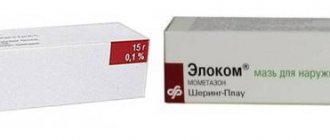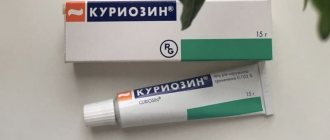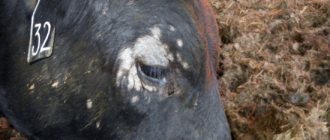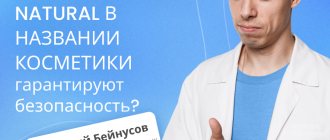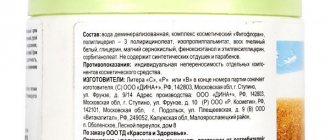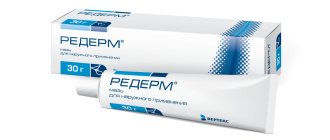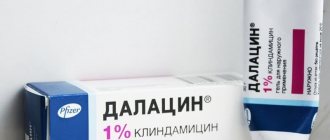Compound
Cynovit shower gel: water, cocamidopropyl betaine, zinc pyrithione, sodium laureth sulfate, acrylic polymer, urea , sodium lauryl-11 carboxylate, glycerin , polyquaternium 7, glyceryl-2 cocoate, climbazole , propylene glycol, disodium EDTA, peppermint oil, methylisothiazolinone, sodium hydroxide , methylchloroisothiazolinone.
Cynovit cream-gel: water, PEG-100 stearate, glyceryl stearate, cetearyl alcohol, isononyl isononanoate, cetearyl glucoside, butylene glycol, isohexadecane, acrylamide/sodium copolymer acryloyldimethyl taurate, polysorbate 80, silica, xanthan gum, methyl methacrylate crosspolymer, pyrroles zinc doncarbonate (zinc PCA), methylchloroisothiazolinone, dipotassium glycyrrhizinate, tocopheryl acetate ( vitamin E ), decylene glycol, retinyl palmitate ( vitamin A ).
Cynovit spray: water, ceteareth-20, cetearyl isononanoate, cetearyl alcohol, glycerin , ceteareth-12, glyceryl stearate, cetyl palmitate, zinc pyrrolidone carbonate (zinc PCA), panthenol , dipotassium glycyrrhizinate, methylisothiazolinone, sodium hydroxide, undecylenamidopropyltrimone ium methyl sulfate, decylene glycol.
Cynovit shampoo: water, cocamidopropyl betaine, sodium laureth sulfate, acrylic polymer, urea , sodium lauryl-11 carboxylate, zinc pyrithione , glyceryl-2 cocoate, polyquaternium 7, propylene glycol, climbazole , panthenol ( vitamin B5 ), cyclopentasiloxane, disodium EDTA, dimethiconol, hydroxide sodium, methylchloroisothiazolinone, peppermint oil, methylisothiazolinone.
Cynovit cream: water, olive oil, glycerin, avocado oil, zinc pyrithione , jojoba oil, shea butter, glyceryl monostearate, cyclopentasiloxane and dimethiconol, stearyl alcohol, ceteareth 6, cetyl alcohol, stearic acid, squalane, palmitic acid, linolenic acid and linoleic triglycerides, carbomer , dipotassium glycyrrhizinate , tocopheryl acetate, methylisothiazolinone, retinol palmitate, decylene glycol, lactic acid , sodium hydroxide, butylated hydroxytoluene.
Pharmacodynamics and pharmacokinetics
Cynovit wash gel and shampoo
zinc pyrithione as one of the active ingredients , which is characterized by anti-inflammatory and antifungal effectiveness, expressed mainly in relation to Pityrosporum orbiculare and Pityrosporum ovale, which are the cause of the inflammatory process and excessive peeling in skin diseases. The antibacterial effect of this component is observed against (Streptococcus spp., Proteus spp., Staphylococcus spp., Pseudomonas aeruginosa and Escherichia coli).
Other active ingredients in shampoo and shower gel are climbazole and urea (urea). Climbazole is an antifungal agent, the effectiveness of which is not inferior to ketoconazole , and urea helps to moisturize the skin and exfoliate dead epithelial particles from it.
Additionally, the shampoo contains panthenol , which exhibits some anti-inflammatory effect and also accelerates epithelization (the formation of fresh tissue in damaged areas).
Cynovit cream-gel and spray
The basis of these cosmetic forms is zinc pyrrolidone carbonate (zinc PCA), which inhibits 5-alpha reductase and reduces the amount of active testosterone found in the sebaceous glands and hair follicles. Zinc PCA reduces the volume of sebum and improves its outflow by reducing viscosity and increasing the elasticity of the walls of the hair follicles. The antibacterial effects of this ingredient are mainly aimed at combating microorganisms : Propionibacterium acnes, Pseudomonas aeruginosa, Staphylococcus epidermalis, Esherichia coli and Staphylococcus aureus.
Other active components - dipotassium glycyrrhizinate (comparable to cortisol in its anti-inflammatory effect), tetranyl-U (characterized by antibacterial and antifungal effectiveness) and panthenol (stimulating skin renewal processes, making it smoother and more elastic) perfectly complement the effects of zinc .
Cynovit cream
The anti-allergenic cream, just like shampoo and gel, contains zinc pyrithione , which reduces the intracellular concentration of ATP and promotes depolarization of cell membranes, leading to the death of bacteria and fungi . This ingredient has anti-inflammatory, antifungal and antibacterial effectiveness, mostly directed against Streptococcus spp., Proteus spp., Staphylococcus spp., Pseudomonas aeruginosa and Escherichia coli. Its sebostatic effect (normalizing the functionality of the sebaceous glands) and keratoregulating effects (suppressing pathological cellular growth of the superficial skin layer and eliminating excessive peeling) are also manifested.
In turn, dipotassium glycyrrhizinate (comparable to cortisol in its anti-inflammatory effect), natural oils (promoting absorption, well absorbed by the skin, nourishing and improving its protective function) and fatty ( linolenic and linoleic ) acids (which are protective components of the skin barrier and support its functionality) potentiate the overall effect of the cream.
Clinical effectiveness of Cynovit cream-gel in the treatment of acne patients
The external cream-gel Cynovit contains modern active components - an innovative molecule of bioactive zinc - zinc dipyrglycan and an anti-inflammatory substance - dipotassium glycyrrhizinate. In a blinded, randomized, placebo-controlled, prospective cohort study lasting six weeks, which included 60 patients with mild to moderate papulopustular acne, the clinical efficacy, safety and tolerability of Cynovit cream-gel were assessed. During therapy, clinical recovery was achieved in 9 (22.5%) patients, significant improvement in 18 (45%), improvement in 13 (32.5%) patients. The results obtained showed the high safety and therapeutic effectiveness of Cynovit cream-gel in the treatment of mild to moderate papulopustular acne.
Table 1. Treatment results for patients with acne
Table 2. Indicators of pH-metry, sebumetry and corneometry before and after treatment
Table 3. Characteristics of study groups and information on side effects
Rice. 1. Patient F. before treatment
Rice. 2. Patient F. after six weeks of treatment with Cynovit cream-gel
Introduction
Acne occupies a leading position among known dermatoses - more than 90% in men and 80% in women. There are several reasons for the development of acne:
- increased sebum production;
- imbalance of lipids in the secretions of the sebaceous glands;
- impaired differentiation of keratinocytes in the area of the sebaceous gland ducts, causing their occlusion;
- colonization by Propionibacterium acnes
; - the formation of inflammatory changes in the area of the pilosebaceous follicle.
Damage to exposed skin areas negatively affects the psycho-emotional state of patients, limits them in many areas of life, causing the development of vegetoneurotic and psychosocial disorders - increased anxiety, low self-esteem, social isolation, depression. In the absence of timely treatment, persistent skin changes can form - scars and hyperpigmentation [1–3].
Clinical manifestations of acne vary from a mild comedonal form to severe inflammatory nodular and conglobate rashes on the face, chest and back. In most cases (over 70%) patients with acne require only local therapy [1, 4].
The interest of dermatovenerologists in the Cynovit line is due to the combination of modern active components of these drugs and high clinical effectiveness [5]. Cynovit contains an innovative molecule of bioactive zinc (zinc dipyrglycan) and an anti-inflammatory substance – dipotassium glycyrrhizinate. The drug has sebostatic and keratoregulating effects by inhibiting the enzyme 5-alpha reductase and reducing the effect of androgen metabolites on sebocytes. In addition, the antibacterial effect of zinc dipyrglycan on P. acnes, Staphylococcus epidermidis, S. aureus, Pseudomonas aeruginosa, Escherichia coli has been proven.
The anti-inflammatory effect of dipotassium glycyrrhizinate is weaker than that of glucocorticosteroids, however, with its long-term use there are no side effects, and due to its chemical stability, good solubility and emulsifying properties, dipotassium glycyrrhizinate is widely used in the cosmetic industry.
The anti-inflammatory activity of dipotassium glycyrrhizinate is also associated with inhibition of the biosynthesis of prostaglandins and leukotrienes from arachidonic acid. Leukotriene B4 takes an active part in the inflammatory process, mediating the chemotaxis of neutrophil leukocytes and increasing plasma exudation. Prostaglandin E2 causes the development of vasodilation and increased vascular permeability of the microvasculature in the skin. Of particular clinical importance is the pronounced ability (three times higher than that of potassium cromoglycate, and 11 times higher than that of indomethacin) of dipotassium glycyrrhizinate to inhibit hyaluronidase, which controls the level of hyaluronic acid in the skin. This enzyme is activated during inflammation and participates in the destruction of the connective tissue matrix, increases the permeability of the membranes of inflammatory cells and blood vessels [5, 6].
Thus, Cynovit line products based on zinc dipyrglycan and dipotassium glycyrrhizinate can be effective in the treatment of acute and chronic inflammatory skin diseases.
The purpose of the study
was an assessment of the clinical effectiveness, safety and tolerability of Cynovit cream-gel in the treatment of patients with mild to moderate acne.
Material and research methods
A blinded, randomized, placebo-controlled, prospective cohort study of six weeks included 60 patients with mild to moderate papulopustular acne. All patients were randomly divided into two groups – main and control. The main group included 40 patients, the control group - 20. Patients were randomized according to the severity of the disease, gender and age. In the main group, Cynovit cream-gel was used as an external agent twice a day. In the control group, a cream base without active ingredients (without dipotassium glycyrrhizinate and zinc salt of pyrrolidone carboxylic acid) was used twice a day. Research Center - Clinic of Skin and Sexually Transmitted Diseases of the Military Medical Academy named after. CM. Kirov.
Criteria for inclusion in the study:
- the patient's desire to participate in the study;
- male and female patients over the age of 14 years;
- the presence of papulopustular acne of mild to moderate severity;
- absence of pregnancy and lactation in women during screening;
- ability to follow protocol requirements.
Exclusion criteria from the study:
- hypersensitivity to any component of the drug;
- the use of systemic therapy for acne less than a month, external treatment - less than two weeks before the start of the study;
- liver and severe renal failure;
- alcohol and drug abuse;
- concomitant skin diseases that may interfere with the assessment of acne;
- participation in other clinical trials.
Criteria for patient withdrawal from the study:
- the appearance of severe undesirable side reactions requiring discontinuation of drugs;
- refusal to continue therapy and/or participate in the study;
- violation of the drug use regimen.
The algorithm for examining patients before starting therapy included:
- assessment of compliance with inclusion/exclusion criteria;
- signing the informed consent;
- collection of medical history (duration of the underlying disease, previous and concomitant diseases, previous therapy, allergy history);
- conducting a clinical examination of blood, urine, biochemical blood test (levels of total protein, total bilirubin, alanine aminotransferase, aspartate aminotransferase, gamma-glutamyltransferase, alkaline phosphatase, glucose, urea, creatinine);
- conducting a pregnancy test in women;
- assessment of dermatological status;
- measuring the level of pH, greasiness and moisture of the facial skin at five points (using the SKIN-O-MAT device, Cosmomed, Germany);
- photographing.
To assess the safety and effectiveness of the therapy, six weeks from the start of treatment, laboratory tests were repeated (in the same volume), the dermatological status was assessed, and the level of pH, greasiness and moisture of the facial skin was measured. The effectiveness of therapy was assessed by counting the number of inflammatory and non-inflammatory elements on one half of the face:
- clinical recovery - complete disappearance of the primary elements of the skin rash;
- significant improvement - resolution of rashes by at least 70% compared to the original data;
- improvement – reduction in the severity of the pathological process by at least 25% compared to the initial data;
- lack of effect – reduction in the severity of the pathological process by less than 25% compared to the initial data;
- deterioration – negative dynamics of the skin process compared to the initial state.
Research results
All 60 patients completed treatment. The results of the study are presented in table. 1–3.
In total, 27 (67.5%) patients achieved clinical recovery and significant improvement in the main group, two (10%) in the control group (Table 1).
In patients of the main group who received Cynovit cream-gel, after six weeks there was a decrease in the skin pH level from 6.9 (5.4–7.6) to 5.8 (4.8–6.3).
A tendency to a decrease in the level of sebaceous secretion of the skin during treatment with Cynovit cream-gel was revealed - from 184.5 (117.2–226.8) to 154.1 (102.4–198.3) μg/cm2 (Table 2).
The results of skin corneometry showed that after six weeks of therapy, the moisture content returned to normal values - from 31.4 (19.2–48.1) to 48.7 (37.2–59.4) arb. units (Table 2).
No adverse reactions requiring discontinuation of the drug were identified during the reporting period (Table 3). Patients noted good tolerance of Cynovit cream-gel. Analysis of the results of general clinical examination of blood and urine, biochemical examination of the blood of patients in both groups during therapy (six weeks from the start of treatment) did not reveal significant deviations from normal values.
Discussion of the research results
The study was aimed at studying the clinical effectiveness, safety and tolerability of Cynovit cream-gel in the treatment of acne patients. The absence of unwanted and side effects, normal laboratory parameters in general clinical and biochemical blood tests at the end of treatment, subjective assessment of the drug by patients convincingly demonstrated the high level of safety and good tolerability of Cynovit cream-gel. At the end of the course of treatment, there was a tendency towards a decrease in pH and a statistically significant increase in skin moisture, reaching the level of normal values. This indicates the presence of a moisturizing property of the Cynovit base, which leads to a reduction in transepidermal water loss and restoration of skin properties (Fig. 1 and 2).
The goal of external acne therapy is to achieve clinical recovery or significant improvement of the process. The results of the treatment showed that the use of Cynovit cream-gel allows achieving this goal in a significant proportion of patients.
conclusions
The results of the study indicate a high level of safety and good tolerability of Cynovit cream-gel. No side effects, including allergic reactions, were observed in patients.
Cynovit cream-gel has demonstrated high therapeutic effectiveness in the treatment of papulopustular acne of mild to moderate severity.
Cream-gel Cynovit in acne patients normalizes moisture and pH levels of the skin.
Cynovit cream-gel can be recommended as a treatment for papulopustular acne of mild to moderate severity.
Indications for use
Shower gel
For hygienic care of the skin of the face and the rest of the body (if necessary) for the following pathological skin conditions: psoriasis ; inguinal dermatophytosis; seborrheic dermatitis ; pityriasis versicolor ; dermatophytosis of smooth skin; atopic dermatitis ( neurodermatitis , eczema ); microsporia (in order to prevent reinfection of fungal strains on other skin areas of the body when washing).
Cream gel and spray
For hygienic skin care for mild, uncomplicated forms of acne , occurring with or without inflammation, as well as for moderate, uncomplicated forms of acne , occurring with or without inflammation (during complex treatment)
In order to prevent the formation (initial or repeated) of fresh comedones and acne .
Shampoo
For hygienic care of the scalp (hair and skin) for skin diseases such as: atopic dermatitis , which appears on the scalp; dandruff ; psoriasis of the scalp; seborrheic dermatitis occurring on the scalp; oily/dry seborrhea ; itching of the skin of the scalp.
Anti-allergenic cream
For hygienic skin care for any pathological skin condition that occurs with symptoms of itching , irritation, peeling and redness in patients over 12 months ( psoriasis , neurodermatitis , atopic/seborrheic dermatitis, eczema , etc.).
In order to eliminate various skin allergic manifestations .
To alleviate the condition of the skin after superficial burns (thermal, solar).
For uncomfortable sensations after an insect bite .
In all pathological cases when external glucocorticoids are contraindicated (including facial skin) or when the patient is wary of their use.
Other forms of release
The drug for treating acne is also available in aerosol form. Spray Cynovit For acne has a similar composition and effect, but has a slightly different method of application.
Before spraying, shake the can vigorously and then apply it to a cotton pad or sterile napkin, using which the product is distributed over the affected areas of the body.
Spray treatment is carried out in the morning and evening hours after washing.
During the post-acne period, the spray is used once a day to prevent the occurrence of new acne.
This release form has similar contraindications for use.
The product is also available in the form of shampoo, shower gel and regular cream.
The shampoo is used to treat seborrheic dermatitis of the scalp, as well as to eliminate acne that has arisen as a result of this dermatological disease.
The gel is used for the whole body as an adjuvant therapy for seborrheic dermatitis, pityriasis versicolor, atopic dermatitis and other skin pathologies.
The cream is intended to eliminate allergic skin reactions in the form of irritation, redness, and acne caused by dermatological diseases. In addition, it can be used to eliminate discomfort after insect bites or superficial burns.
Instructions for use Cynovit
Cynovit gel, instructions for use
Before use, the bottle of shower gel should be shaken vigorously several times. Then, opening the lid, squeeze out the required amount of gel from the bottle and distribute evenly over the skin in need of treatment, leaving it there for 2-3 minutes. After this time, it is necessary to thoroughly rinse off the remaining gel with warm water.
Cynovit gel, throughout the entire period of treatment of fungal pathologies of the skin or other skin diseases ( eczema , atopic/seborrheic dermatitis , etc.), should be used as the only cosmetic/medicinal product for washing the skin of the face and body (do not use other medicinal ointments , creams, lotions, etc.).
After completion of treatment, you can use shower gel for prophylactic purposes, applying it to the skin 1-2 times every 7 days.
Instructions for cream gel
Cynovit cream-gel is indicated for external use once or twice every 24 hours (morning and evening), applying the product to the affected skin areas of the body and/or face in an even thin layer.
For preventive purposes (to prevent the occurrence of fresh pimples and/or blackheads ), the cream-gel should be applied once a day before bedtime.
After the disappearance of the negative symptoms of the skin disease, it is necessary to continue the usual procedures for applying the cosmetic product for another 7-14 days.
The duration of use of the cream gel is not limited.
Cynovit shampoo, instructions for use
The use of shampoo involves uniform distribution of its small volume over the entire surface of the scalp. Then, for 60 seconds, gently massage the skin under the hair with soft movements of the hands. Then you need to thoroughly rinse off the shampoo, reapply it to the same area, leave it there for 2-3 minutes and rinse your hair thoroughly.
In order to eliminate dandruff , a 30-day use of shampoo is recommended at intervals of 2-3 times every 7 days.
To prevent dandruff , you should use shampoo once or twice a week.
Instructions for the spray
Before using the spray, you need to vigorously shake the bottle several times, then from a distance of approximately 15 centimeters, evenly spray its contents onto problematic skin surfaces.
To apply the spray to the skin of the face, it is necessary to spray the contents of the bottle onto a cotton pad or swab from a distance of approximately 5 cm, and then wipe the affected skin areas on the face with it.
Problematic skin areas should be treated twice every 24 hours (morning and evening). After the disappearance of external manifestations of the skin disease, it is necessary to use the spray for another 7-14 days.
For preventive purposes (to prevent the occurrence of fresh pimples and/or blackheads ), the spray should be sprayed once or twice a day.
The duration of use of the spray is not limited.
Cynovit cream, instructions for use
Anti-allergenic cream should be used twice every 24 hours (morning and night), applying it in an even thin layer to the affected skin areas of the face and/or other parts of the body.
The duration of therapy for dermatitis is 3-4 weeks, treatment for psoriasis takes 4-6 weeks. For other skin pathologies, it is practiced to apply the cream until the external negative manifestations completely disappear.
Contraindications
Problems when using the drug can begin with individual intolerance to one of the active ingredients, which can result in allergic reactions, urticaria and even contact dermatitis.
It is also not recommended to apply Cynovit cream during pregnancy, since zinc pyrithione accumulates in the deep layers of the epidermis and can penetrate into the systemic bloodstream, which can affect the health of mother and child. In general, during such a period of time, we recommend having minimal, both external and internal effects on the body.
Analogs
Analogues of cream, gel, shampoo, cream-gel and spray Cynovit are represented by external medicinal agents used for similar indications:
- Zinc ointment / paste ;
- Belosalik;
- Desitin;
- Cutivate;
- Sudocrem;
- Bepanten;
- Advantan;
- Tsindol;
- Akriderm;
- Forethal;
- Primalan;
- We see;
- Tsinocap;
- Protopik;
- Ugrin , etc.
Analogues of Cynovit: which are the most inexpensive
Cynovit gel cream has no analogues in composition, but substitutes based on the principle of action can be found on sale, among which are:
- Zinc ointment;
- Sudocrem;
- Differin;
- Boro Plus.
Zinc ointment has a drying, antimicrobial and anti-inflammatory effect. Its main components are zinc oxide and petroleum jelly. The ointment helps in case of minor rashes. For severe acne, it is ineffective.
Sudocrem contains zinc oxide, which helps relieve inflammation and prevent a further increase in the population of pathogenic bacteria. Additionally, the component helps relieve irritation and promotes the healing of post-acne scars. Other active substances enhance the therapeutic effect of the medication for external use. The drug is used for mild acne.
Differin is available in the form of cream and gel, containing components that are aimed at fighting acne and act in several directions at once. The main active ingredient has strong anti-inflammatory and comedolytic properties. Differin eliminates not only acne, but also comedones and blackheads.
Boro Plus consists exclusively of natural ingredients that have antiseptic, anti-inflammatory and healing effects. Its use is effective for mild forms of acne.
Reviews about Cynovit
Reviews of Cynovit shampoo when used against manifestations of psoriasis , dandruff and other similar diseases are divided approximately equally. Some people were completely satisfied with its effect, others, on the contrary, did not feel any positive effect of the shampoo and even identified a number of side effects ( dryness , tangling and even hair loss ).
Against this background, reviews of the shower gel are much better, perhaps due to the smaller appearance of various skin rashes on areas of the body that are devoid of dense hair.
Reviews for cream-gel and spray for acne and acne are approximately the same and in most cases are positive. Spray and cream-gel for problem skin have proven themselves quite well and are quite popular among people with various diseases accompanied by skin rashes all over the body. Negative reviews about Cynovit spray and acne cream gel mainly indicate gradual addiction to the ingredients of these products, after which a decrease in their effectiveness is observed.
As is the case with shampoo. reviews of Cynovit cream were distributed approximately 50/50 between positive, when the effects of the cream helped get rid of skin rashes , and negative, when its use did not lead to any changes in the condition of the skin.
Cynovit price, where to buy
In Russia, the average price of Cynovit shampoo is 240 rubles, the price of Cynovit shower gel (washing gel) is 250 rubles, the price of cream gel and the price of Cynovit spray is 300 rubles, the price of Cynovit cream is 330 rubles.
In Ukraine, the average price of Cynovit shower gel and cream gel is 140 hryvnia, you can buy shampoo and cream for 150 hryvnia, the cost of a spray is approximately 160 hryvnia.
- Online pharmacies in RussiaRussia
- Online pharmacies in UkraineUkraine
ZdravCity
- Cynovit anti-dandruff shampoo 150 mlGreen Dubrava JSC
RUB 314 order - Cynovit spray for problem skin 75 mlGreen Dubrava JSC
RUB 336 order
- Cynovit cream for irritation, redness, peeling and itching 40mlGreen Dubrava JSC
RUB 307 order
- Cynovit shower gel 150mlGreen Dubrava JSC
RUB 289 order
- Cynovit cream-gel for the care of problem skin 35mlGreen Dubrava JSC
RUB 365 order
Pharmacy Dialogue
- Cynovit (shampoo 150 ml)Green oak grove
RUB 303 order
- Cynovit (spray for skin problems 75ml)Green oak grove
RUB 388 order
- Cynovit (cream-gel for acne, pimples/blackheads, tube 35ml)Green oak grove
405 rub. order
- Cynovit (cream for skin test 40ml)Green oak grove
RUB 332 order
- Cynovit (gel for shower 150ml)Green oak grove
300 rub. order
show more
